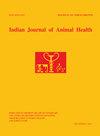银纳米颗粒在多种动物伤口愈合中的局部应用
IF 0.5
4区 农林科学
Q4 AGRICULTURE, DAIRY & ANIMAL SCIENCE
引用次数: 0
摘要
背景:在动物中,由于多种因素,有时用局部消毒敷料和常规药物治疗伤口不能取得令人满意的结果,这对兽医来说是一个挑战。由于不同形态的纳米银粒子具有抗菌和促进创面愈合的特性,被广泛应用于人体创面治疗。纳米银颗粒在动物慢性复杂伤口愈合中的应用,特别是在临床病例中的应用文献很少。方法:选取犬(n=20)、山羊(n=6)、猫(n=1)、水牛(n=1) 27只不同种类、不同身体部位不同类型慢性复杂伤口的动物。评估后的创面根据情况进行常规消毒敷料和其他所需的肠外药物治疗,最初3天。所有伤口也接受局部应用银纳米颗粒(100 ppm AgNOs喷雾剂),每天两次。出现的当天被认为是第0天,随后记录肉芽、伤口收缩和完全愈合的天数。结果:20例犬创面5 ~ 12 d出现组织肉芽,创面收缩,15 ~ 32 d创面完全愈合,有无瘢痕形成。6例母山羊患者根据伤口部位和深度不同,创面在第16 ~ 19天完全愈合。第3 ~ 5天,头部、外阴周围、会阴、腹部创面出现明显肉芽,创面收缩明显。与其他部位的伤口相比,四肢伤口的肉芽较少。从第5天开始,在肢体部位观察到肉芽肿。所有病例的愈合时间从第10天到第32天不等。本文章由计算机程序翻译,如有差异,请以英文原文为准。
Topical Applications of Silver Nanoparticles for Wound Healing Enhancement in Various Animals
Background: In animals due to multiple factors sometime wound management with topical anti-septic dressing along with routine medication does not give any satisfactory outcome and becomes a challenge for the veterinarians. Due to antibacterial and wound healing enhancement properties of silver nano-particles in different forms, it is widely used topically in human wound therapy. The application of silver nano-particles in wound healing in chronic complicated wounds in animals especially in clinical cases is very less documented. Methods: Total twenty seven animals of various species, viz., dogs (n=20), goats (n=6), cat (n=1) and buffalo (n=1) presented with different types of chronic complicated wounds on different body parts were included in this study. The wounds after evaluation were treated according to conditions with routine antiseptic dressing with other required parenteral medications for initial 3 days. All the wounds were also subjected for topical application of silver nano-particles (100 ppm AgNOs spay) twice a day. The day of presentation was considered as a day ‘0’ and subsequent days for granulation, wound contraction and complete healing were recorded. Result: Amongst 20 canine wound cases, granulation of tissues with wound contraction was noted in around 5-12 days and complete healing of wound with or without scar formation was observed in 15-32 days. Among the six female goat patients, complete wound healing was observed on day 16 to day 19 according to the site and depth of wounds. In the wounds located on head, perivulvar, perineal, abdominal regions showed the marked granulation from day 3 to day 5 along with remarkable wound contraction. The wounds presented on limbs exhibited less granulation compared to wounds presented on other parts. The granulation was observed from day 5th on limb region. In all the cases healing period was found variable from day 10 to day 32.
求助全文
通过发布文献求助,成功后即可免费获取论文全文。
去求助
来源期刊

Indian Journal of Animal Research
AGRICULTURE, DAIRY & ANIMAL SCIENCE-
CiteScore
1.00
自引率
20.00%
发文量
332
审稿时长
6 months
期刊介绍:
The IJAR, the flagship print journal of ARCC, it is a monthly journal published without any break since 1966. The overall aim of the journal is to promote the professional development of its readers, researchers and scientists around the world. Indian Journal of Animal Research is peer-reviewed journal and has gained recognition for its high standard in the academic world. It anatomy, nutrition, production, management, veterinary, fisheries, zoology etc. The objective of the journal is to provide a forum to the scientific community to publish their research findings and also to open new vistas for further research. The journal is being covered under international indexing and abstracting services.
 求助内容:
求助内容: 应助结果提醒方式:
应助结果提醒方式:


